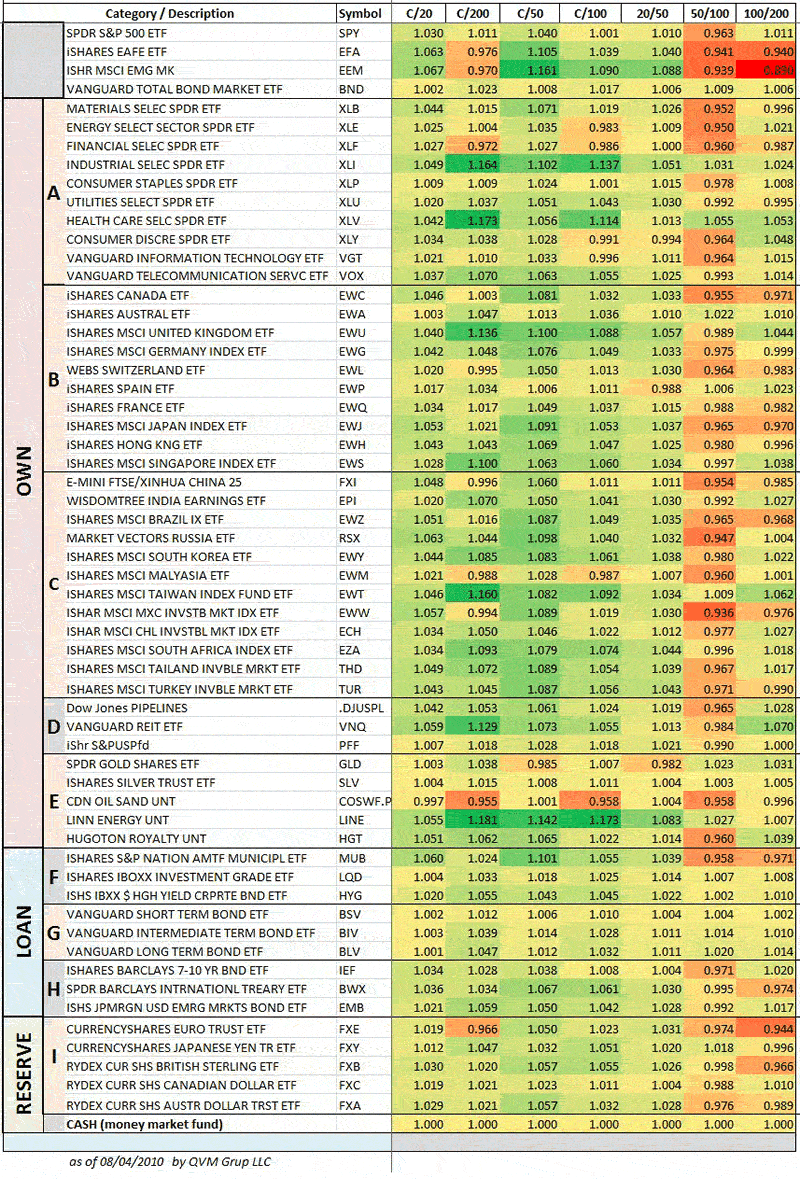Price and Moving Average Stacking For Category Representative ETFs
Companies / Exchange Traded Funds Aug 11, 2010 - 01:24 AM GMTBy: Richard_Shaw
 The table image uses color coding to help visualize which key ETF categories are in the strongest and weakest price patterns as indicated by the stacking of the price and various moving averages to each other.
The table image uses color coding to help visualize which key ETF categories are in the strongest and weakest price patterns as indicated by the stacking of the price and various moving averages to each other.
An ideal stacking would be for the price to be above the 20-day average, which would be above the 50-day average, which would be above the 100-day average, which would be above the 200-day average. The worst case would have the opposite stacking.
There is certainly more to consider about price patterns than moving averages, and fundamental and macro-economic issues are necessary too when making decisions, but moving averages are one important dimension. The table below (as of 08/04/2010) allows side-by-comparison of moving averages for a a few dozen non-overlapping funds in several distinct asset categories.
In this image, the greener and darker the cells, the more favorable. The more red and darker red cells are the less favorable.

The top four securities are for the largest categories: US stocks (SPY), non-US developed market stocks (EFA), emerging market stocks (VWO) and US aggregate bonds (BND).
The "A" through "I" groupings are for:
- A: Domestic Stock Sectors
- B: Non-US Developed Mkt Countries
- C: Emerging Mkt Countries
- D: Special Stocks for Income
- E: Commodities
- F: Domestic Bonds - Credit
- G: Domestic Bonds - Duration
- H: Sovereign Bonds
- I: Currencies
All of the funds are in pretty good shape with respect to their 20-day average, and all but a few are above their 200-day average (unlike a few weeks ago). EAFE stocks, emerging market stocks, and S&P 500 financials are 2% to 3% below their 200-day averages. The 100-day average for the emerging markets is below its 200-day average by the widest amount of those that are below.
The color and color deepness can guide you through the rest.
We use this sort of chart for moving averages and several other price pattern dimensions on these securities and other securities as a way to take a quick wide angle view of the markets, before looking more intensely at target categories or securities.
ETFs Cited: SPY, EFA, VWO, BND.
Holdings Disclosure: As of August 5, 2010 wt own some of the 58 securities listed in the table, but not most -- more of the LOAN category and less of the OWN category (as grouped in the table).
By Richard Shaw
http://www.qvmgroup.com
Richard Shaw leads the QVM team as President of QVM Group. Richard has extensive investment industry experience including serving on the board of directors of two large investment management companies, including Aberdeen Asset Management (listed London Stock Exchange) and as a charter investor and director of Lending Tree ( download short professional profile ). He provides portfolio design and management services to individual and corporate clients. He also edits the QVM investment blog. His writings are generally republished by SeekingAlpha and Reuters and are linked to sites such as Kiplinger and Yahoo Finance and other sites. He is a 1970 graduate of Dartmouth College.
Copyright 2006-2010 by QVM Group LLC All rights reserved.
Disclaimer: The above is a matter of opinion and is not intended as investment advice. Information and analysis above are derived from sources and utilizing methods believed reliable, but we cannot accept responsibility for any trading losses you may incur as a result of this analysis. Do your own due diligence.
Richard Shaw Archive |
© 2005-2022 http://www.MarketOracle.co.uk - The Market Oracle is a FREE Daily Financial Markets Analysis & Forecasting online publication.



